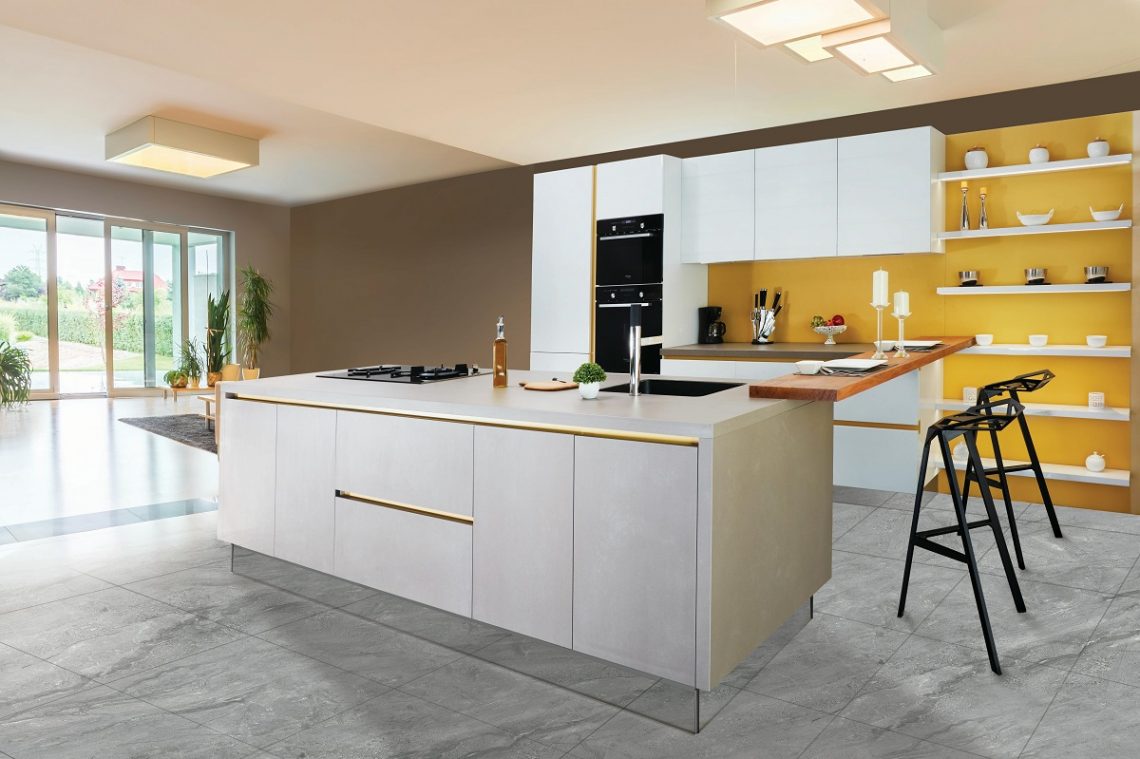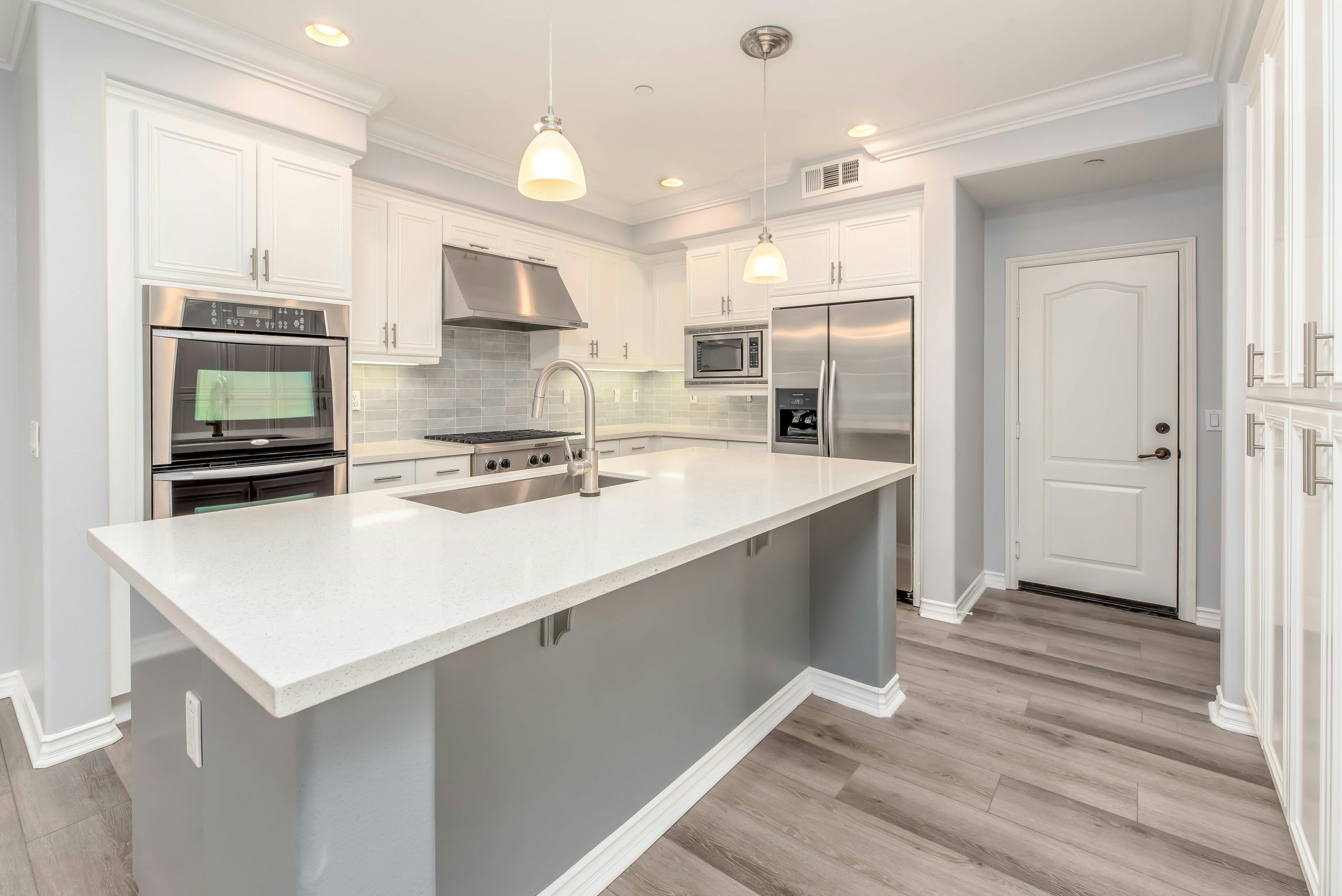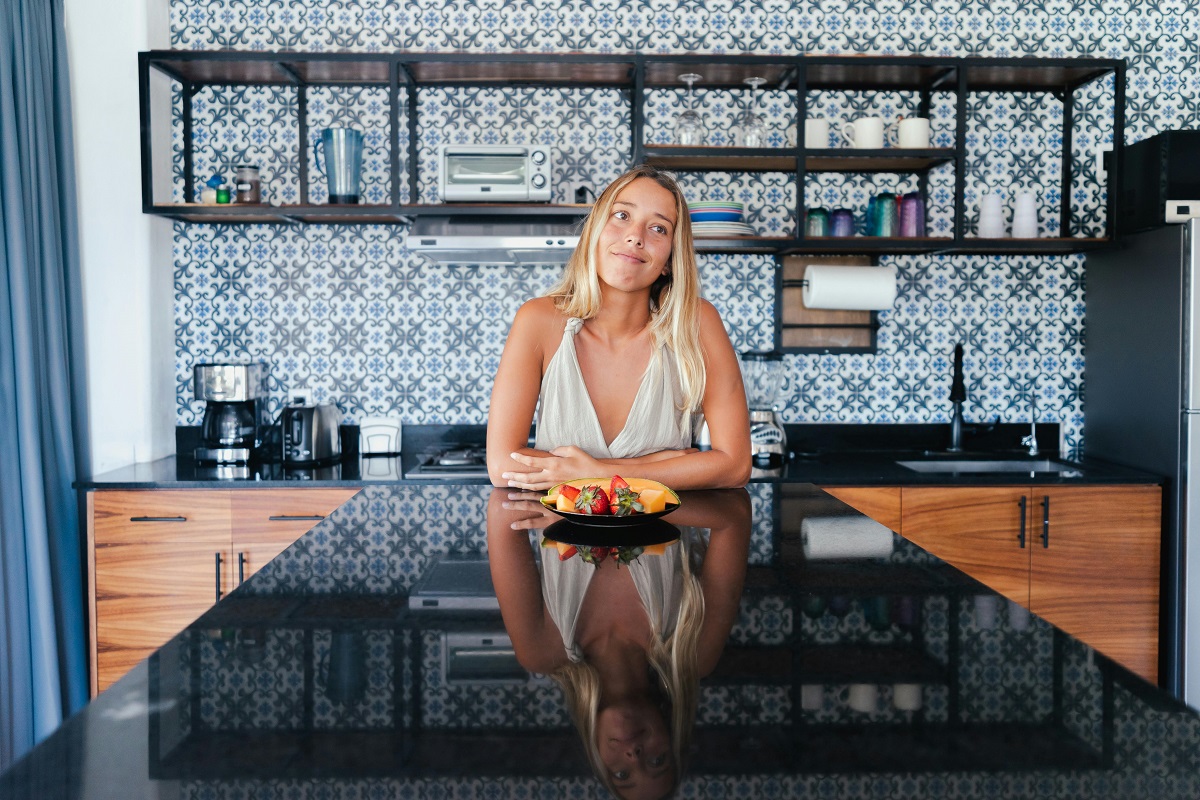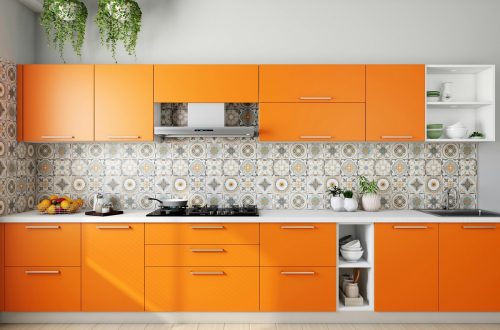
- Light and neutral colors visually expand space – Whites, off-whites, soft grays, and beige tones reflect light, making small kitchens feel brighter and more open.
- Pastels add personality without shrinking the room – Soft blues, mint greens, and blush pinks introduce color while maintaining an airy feel.
- Reflective finishes and good lighting enhance perception – Satin or semi-gloss paints, combined with natural and layered artificial lighting, make walls appear larger.
- Color zoning and accents create depth – Accent walls, vertical color blocks, and painted backs of open shelving add dimension without overcrowding the space.
- Monochromatic schemes streamline small kitchens – Matching or coordinating wall and cabinet colors creates a seamless, expansive appearance.
- Patterns and accessories should be subtle – Small artwork, mirrors, metallic accents, and minimal textures enhance style while keeping the kitchen open.
- Testing colors and avoiding common mistakes is crucial – Sampling wall colors, coordinating with existing elements, and steering clear of too many dark shades prevent a cramped, cluttered look.
Small kitchens can feel cozy, but they can also feel cramped if not designed thoughtfully. One of the simplest and most effective ways to make a small kitchen appear larger is by choosing the right wall colors. This guide will explore everything you need to know about selecting kitchen wall colors that open up space, reflect light, and create a more inviting atmosphere.
Why Do Wall Colors Matter in Small Kitchens?
The color of your kitchen walls does more than just make the room look pretty. Wall colors can influence:
- Perceived space – Lighter colors can make a room feel more expansive, while dark colors can make it feel smaller.
- Mood and energy – Certain colors, like warm yellows or soft greens, can make your kitchen feel cheerful and inviting.
- Style cohesion – Wall colors help tie together cabinets, countertops, flooring, and appliances.
Understanding these factors can guide your choice of kitchen wall colors to make a small space feel bigger and more harmonious.
What Are the Best Colors for Small Kitchens?
Not all colors work equally well in tight spaces. Some shades naturally open up a room and make it feel airy, while others can make a small kitchen feel cramped or dark. Choosing the right colors is essential to maximize space, light, and style. Here’s a breakdown of the best options for small kitchens:
Light and Neutral Shades
Light colors are the easiest and most effective way to visually enlarge a space. They reflect natural and artificial light, creating a brighter, more open feeling.
- Whites and off-whites – These classic shades are timeless and versatile. White walls reflect the most light, instantly making your kitchen feel larger and cleaner. Off-whites, cream whites, and soft eggshell tones add warmth while still maintaining the airy effect. These shades pair well with nearly any cabinetry, countertop, or flooring choice.
- Soft grays – Gray is a subtle and modern alternative to white. Light grays work especially well with stainless steel appliances, creating a sleek, contemporary look. Soft gray walls add sophistication without feeling heavy, and they can act as a neutral base for colorful accents like kitchen accessories or small appliances.
- Beige or cream tones – Warm neutrals, such as beige, taupe, or light cream, create a cozy yet open atmosphere. These shades are perfect for kitchens that aim for a welcoming, homey vibe. Beige and cream walls complement natural wood cabinets or stone countertops, and they make the space feel both grounded and airy at the same time.
Soft Pastels
Pastel shades introduce personality and color without overwhelming a small kitchen. They reflect light similarly to neutrals but add a hint of freshness and style.
- Pale blue – This gentle color promotes a sense of calm and serenity. Pale blue reflects natural light beautifully, making the kitchen feel brighter and more spacious. It works particularly well in kitchens with white or light wood cabinets.
- Mint green – A soft mint adds a refreshing touch while keeping the room light. Mint pairs beautifully with white or cream cabinetry and can create a subtle retro or coastal feel. This color works best when used on all walls or as an accent behind open shelving.
- Blush pink – Light pink adds warmth and charm without dominating the space. It brightens corners and softens the overall look of the kitchen. Blush pink walls work especially well with gold or brass hardware and white cabinetry, offering a modern, sophisticated twist on a pastel palette.
Accents That Work
While the main walls should generally remain light to maximize the perception of space, small pops of color can add personality and style without making the room feel cramped. Consider:
- Backsplashes – A colorful or patterned backsplash behind your stove or sink adds depth and visual interest while keeping the walls light. Tiles with subtle hues or metallic accents can create the illusion of extra space.
- Open shelving – Painting the back wall of open shelves in a soft or bold color can add dimension and highlight decorative items without overwhelming the room.
- Small wall art or framed prints – Incorporating tiny pieces of artwork or prints can personalize the kitchen and introduce a splash of color. Keep frames simple and minimalistic to avoid cluttering the visual space.
Using these accent techniques allows you to inject color and personality while still keeping your small kitchen open, airy, and visually expansive.
How Can Wall Colors Affect Light in Your Kitchen?
Light plays a crucial role in the perception of space. Kitchen wall colors can either enhance or hinder this effect.
Use Reflective Finishes
- Satin or semi-gloss paints bounce light around the room.
- Avoid flat or matte finishes in tiny kitchens, as they can absorb light and make walls appear dull.
Maximize Natural Light
- Choose wall colors that complement your windows’ light.
- Light blues, creams, and soft yellows reflect sunlight effectively.
Layer Artificial Lighting
Even with perfect wall colors, small kitchens need good lighting. Consider:
- Under-cabinet lights
- Pendant lights over counters
- Bright, energy-efficient ceiling fixtures
The combination of light-colored walls and layered lighting can significantly increase the perceived size of a kitchen.
Can Color Zoning Make Your Kitchen Feel Bigger?
Yes. Using different but coordinated colors in separate areas can create a sense of depth and space.
- Accent walls – A slightly darker or bolder wall in one area draws the eye and adds dimension.
- Vertical color blocks – Painting a section of the wall in a contrasting color can make ceilings appear higher.
- Open shelving in a different color – Helps break up visual monotony and creates an illusion of more space.
Should Cabinets and Walls Be the Same Color?
Matching cabinets and walls can streamline a small kitchen and make it feel larger.
- Monochromatic schemes – Choosing shades from the same color family for walls and cabinets creates a seamless, expansive look.
- Contrasting cabinets – If you prefer contrast, keep the wall color very light and neutral to avoid shrinking the space visually.
Tips for Monochromatic Kitchens
- Use a slightly darker shade for cabinets than walls for depth.
- Keep countertops and backsplashes light to maintain brightness.
- Add metallic or glass accents for reflections.
How Do You Choose Colors That Reflect Your Style?
Even in a small kitchen, your personal style matters. Consider these ideas:
- Modern and minimal – Cool grays, crisp whites, and black accents.
- Rustic or farmhouse – Creams, soft sage green, or muted taupe.
- Coastal-inspired – Soft blues, aqua, and sandy neutrals.
- Eclectic or colorful – Stick to one or two accent colors to keep the space open.
Can Patterns Help or Hurt a Small Kitchen?
Patterns can add personality, but in small kitchens, they need to be used carefully.
- Avoid large-scale patterns – Big stripes or bold prints can overwhelm the space.
- Opt for subtle textures – Lightly patterned wallpaper, tile, or textured paint can create visual interest without shrinking the room.
- Use patterns as accents – Consider patterned backsplashes or small decorative tiles instead of full walls.
How Do Ceilings and Trim Affect the Sense of Space?
Ceilings and trim color can amplify the effect of your kitchen wall colors:
- White or light ceilings make rooms feel taller.
- Painting trim the same color as walls reduces visual breaks and creates a continuous flow.
- Light-colored moldings provide a clean frame without drawing attention away from the walls.
What Are Some Common Mistakes to Avoid?
Even with the right wall colors, certain mistakes can make small kitchens feel cramped:
- Using too many dark colors – Deep shades can feel cozy in large kitchens, but shrink smaller ones.
- Ignoring lighting – Dark corners and insufficient lighting negate the effect of light walls.
- Overdecorating walls – Too many shelves, frames, or artwork can clutter the visual space.
- Clashing colors with cabinets or floors – Ensure colors coordinate to prevent visual chaos.
How Can You Test Wall Colors Before Committing?
Before painting the entire kitchen, test colors to avoid regrets:
- Sample large patches – Paint a section of each wall to see how it reacts to light.
- Check at different times – Observe how the color changes in morning, afternoon, and evening light.
- Use swatches with your cabinets and counters – Ensure harmony across surfaces.
Are There Specific Paint Brands or Finishes Recommended?
While the brand isn’t as important as the color and finish, some paints perform better in kitchens:
- Satin or semi-gloss finishes – Durable, easy to clean, and reflective.
- Moisture-resistant paints – Ideal for areas near sinks and stoves.
- High-quality pigments – Reduce fading over time and provide consistent coverage.
Popular brands often recommended by interior designers include Benjamin Moore, Sherwin-Williams, and Behr.
Can Accessories Influence How Wall Colors Feel?
Yes, accessories can enhance the effect of your chosen wall colors:
- Mirrors – Reflect light and make walls appear further away.
- Glass-front cabinets – Create a sense of openness.
- Metallic accents – Silver, gold, or copper details add reflection and depth.
- Light-colored flooring or rugs – Helps complement wall colors and expand the room visually.
How to Incorporate Bold Colors Without Shrinking the Space
If you love bold colors, you don’t have to give them up:
- Feature walls – Paint one small wall in a bold color while keeping others light.
- Backsplash or cabinetry accents – Bright shades can be integrated in smaller doses.
- Accessories and decor – Towels, appliances, or artwork in your favorite bold color can add personality without closing in the space.
Kitchen Wall Colors Checklist for Small Spaces
Use this checklist when planning your kitchen wall colors:
- Are my walls light or reflective enough to bounce light?
- Do my wall colors coordinate with cabinets, countertops, and floors?
- Am I avoiding too many dark shades that shrink the space?
- Have I tested colors at different times of the day?
- Am I using accents strategically rather than overloading walls?
- Does my color choice match my style while keeping the room airy?
In a Nutshell
Small kitchens don’t have to feel cramped or cluttered. With the right kitchen wall colors, strategic lighting, and thoughtful accents, you can make even the tiniest space feel open, inviting, and stylish.
Lighter shades, reflective finishes, and subtle pastels work wonders, while careful use of bold colors adds character without sacrificing space. Remember, walls are just one piece of the puzzle—lighting, cabinets, and accessories all play a role in creating a kitchen that feels bigger and more comfortable.
By following these guidelines, testing your colors, and staying mindful of coordination and light, your small kitchen can transform from cramped to cozy and stylish. The right wall colors are the simplest, most effective tool you have to make your kitchen feel bigger.





